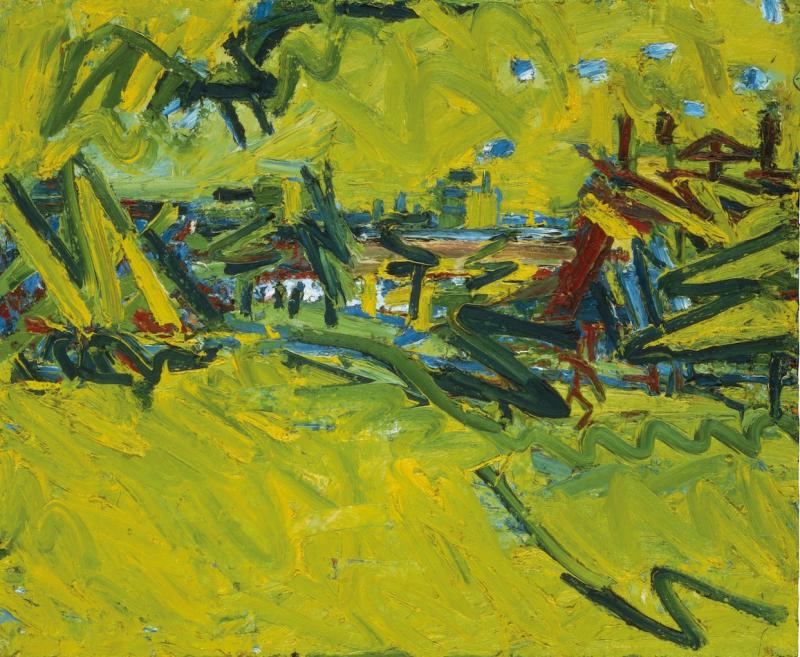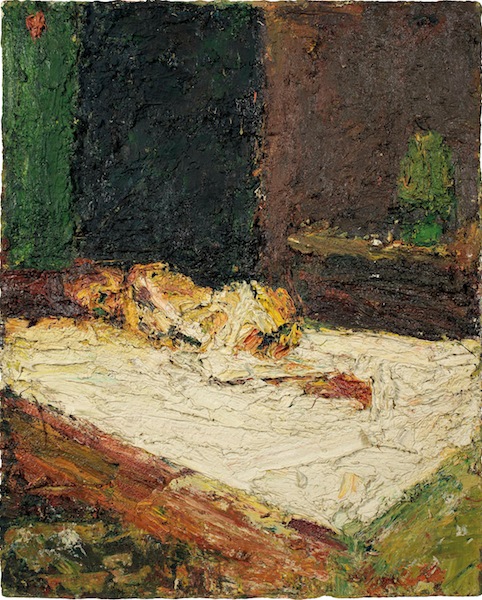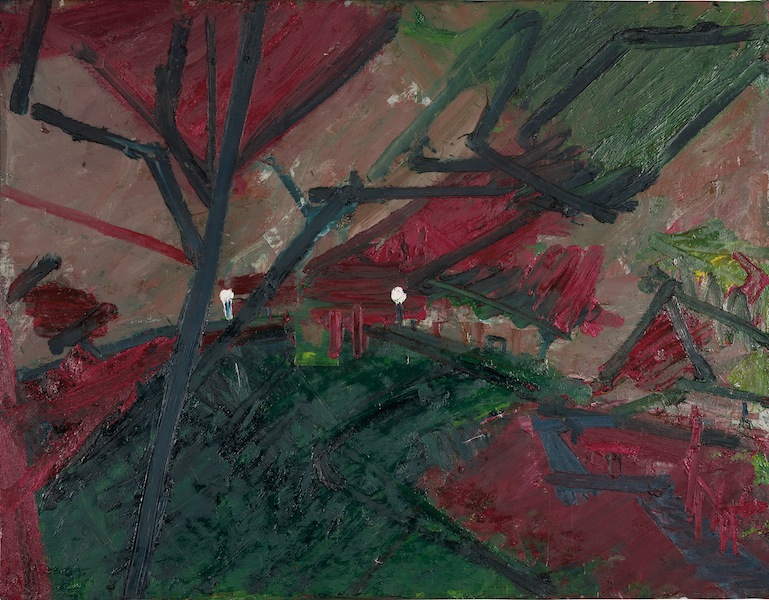Frank Auerbach, Tate Britain | reviews, news & interviews
Frank Auerbach, Tate Britain
Frank Auerbach, Tate Britain
Rough and vivid, these paintings are the opposite of idealised, but nonetheless seductive

A finely honed and spacious selection dating from the 1950s to now, looks in acute focus at the work – a scatter of drawings, a print, but almost entirely paintings – of Frank Auerbach, (b 1931). An only child, he came without his family, from Berlin to England in 1939. His parents were murdered in the Holocaust. He is now one of the most remarkable painters of our time.
Work chosen by the artist himself is arranged in six galleries each spanning a decade: each image is a commanding presence, and the paintings range in size, scale and subject matter from the substantial to domestic intimacy. The final large double gallery is a selection from all periods chosen by the curator and writer Catherine Lampert who has not only organised other significant exhibitions of Auerbach, but has also been a sitter to the artist for nearly 40 years.
Auerbach is famously totally occupied with his work in his studio, but not a recluse; for although he paints every day, he has been an adept at the occasional surprising interviews and conversations which illuminate not only his work but that of other artists. Moreover, he is acutely aware of art history, drawing from art he admires and looks at intensely in the National Gallery.
This knowledge, a passion for looking and learning in that most satisfactorily old-fashioned way, copying, riffing if you like on paintings which become ghostly companions, is subsumed in the strikingly subtle architectural qualities of his cityscapes. His pictorial organisation of street scenes is devoid of direct human presence, although resonant with human artefacts from buildings to pillar boxes. Uncannily at many removes they can echo the composition of Renaissance mythologies. An early nude E.O.W.Nude on Bed, 1959 (pictured below left), is a kind of succinct summary, recalling the classic old mastery subject from Titian of the reclining naked woman. Many of the paintings look just at a head – in profile, or often, characteristically reclining.
 An Auerbach, rough and vivid, is the opposite of idealised, or even in any way conventionally realistic. Rather it is full, indeed jam packed with the here-and-now, the quotidian, what the artist looks at every day, even at times rowdy. Painting is another word for feeling. Auerbach has said how looking at the same things and people so obsessively is a kind of understanding of time, as things and people are in a continual state of flux. He is famous for encrusted paint, with a modus operandi that for most of his working life has involved making a painting, starting again by scraping off all the paint – although echoes may be left – and starting again, until one day it feels right. It is as though the sheer physicality of his painting is a way of pinning something down, unerringly.
An Auerbach, rough and vivid, is the opposite of idealised, or even in any way conventionally realistic. Rather it is full, indeed jam packed with the here-and-now, the quotidian, what the artist looks at every day, even at times rowdy. Painting is another word for feeling. Auerbach has said how looking at the same things and people so obsessively is a kind of understanding of time, as things and people are in a continual state of flux. He is famous for encrusted paint, with a modus operandi that for most of his working life has involved making a painting, starting again by scraping off all the paint – although echoes may be left – and starting again, until one day it feels right. It is as though the sheer physicality of his painting is a way of pinning something down, unerringly.
His eye has clearly tended with a kind of ferocity – who better to know his work than the artist himself? – to the Tate selection and arrangement. He is like a hunter stalking his prey, hanging the trophies on the wall. It is significant that the overwhelming majority of the paintings have come from private collections; perhaps the artist himself wanted to see them again. Rarely can a show have been so arranged with just half a dozen to a dozen or so works in each large gallery, the walls painted a memorable bluish-grey, or greyish-blue, an oddly ambiguous colour which nevertheless sets off the paintings with outstanding clarity. It is as though each image bursts forth determining and demanding its own space, and a lot of it at that, away from domestic claustrophobia.
Part of the wholly unexpected result, to this viewer at least, is that Auerbach, who claims that even his paintings are drawings, emerges as a master of colour. Winter Evening, Primrose Hill Study, 1974-5 (pictured below), uses earth colours, dark reds and greens but somehow catches that lowering light of winter darkness, a light that is both dead and peculiarly glowing. Bare branches form a kind of scaffolding for the unexpected colour spectrum.
 Mornington Crescent – Early Morning, 1991, is almost the opposite, buildings outlined like a child’s painting, tilting every which way and the whole wrapped in oranges and pinks, that affecting moment of the day when the emerging light begins to embrace the city. Slashes of red define the curve of Primrose Hill, 1971, under a mildly riotous blue sky. One painting, Sketch for To the Studios III, 1985, has lettering that indicates the direction of Auerbach’s daily life, that walk to the workroom, described as imagination’s chamber.
Mornington Crescent – Early Morning, 1991, is almost the opposite, buildings outlined like a child’s painting, tilting every which way and the whole wrapped in oranges and pinks, that affecting moment of the day when the emerging light begins to embrace the city. Slashes of red define the curve of Primrose Hill, 1971, under a mildly riotous blue sky. One painting, Sketch for To the Studios III, 1985, has lettering that indicates the direction of Auerbach’s daily life, that walk to the workroom, described as imagination’s chamber.
The subjects that have captivated him, relentlessly, are a small circle of people, a small area of London. He famously paints only people who are not only known to him, but known for decade upon decade; and the geographic area of London around his studio – Primrose Hill, Mornington Crescent, the streets of Camden Town – where he has lived and worked for most of his life.
It is a kind of seduction, but the opposite of glamorous: it is the determinedly everyday. He has told us that he is as a migrant passionately English, and can hardly bear to leave London, and indeed has rarely done so. Charting his initial reaction to Auerbach’s art, T.J Clark, historian of the French 19th century, asked “why the way to freedom in painting should be via the incomprehensible”, a profound conundrum for many concerning modern and contemporary art. This is à propos of Clark’s slow realisation of the unshakeable memorability and insinuation into the mind’s eye of Auerbach’s imagery.
This is not a complete view of Auerbach: he is a master printmaker, and there are countless drawings in his oeuvre, with only a handful here. Another series of huge paintings of London building sites of several decades ago, away from his near life-long obsession with his immediate surroundings, are also not displayed. So this is not a conventional retrospective, but an artist’s view of his art – and beyond that, of art itself.
Share this article
The future of Arts Journalism
You can stop theartsdesk.com closing!
We urgently need financing to survive. Our fundraising drive has thus far raised £49,000 but we need to reach £100,000 or we will be forced to close. Please contribute here: https://gofund.me/c3f6033d
And if you can forward this information to anyone who might assist, we’d be grateful.

Subscribe to theartsdesk.com
Thank you for continuing to read our work on theartsdesk.com. For unlimited access to every article in its entirety, including our archive of more than 15,000 pieces, we're asking for £5 per month or £40 per year. We feel it's a very good deal, and hope you do too.
To take a subscription now simply click here.
And if you're looking for that extra gift for a friend or family member, why not treat them to a theartsdesk.com gift subscription?
more Visual arts
 'We are bowled over!' Thank you for your messages of love and support
Much-appreciated words of commendation from readers and the cultural community
'We are bowled over!' Thank you for your messages of love and support
Much-appreciated words of commendation from readers and the cultural community
 Kerry James Marshall: The Histories, Royal Academy review - a triumphant celebration of blackness
Room after room of glorious paintings
Kerry James Marshall: The Histories, Royal Academy review - a triumphant celebration of blackness
Room after room of glorious paintings
 Folkestone Triennial 2025 - landscape, seascape, art lovers' escape
Locally rooted festival brings home many but not all global concerns
Folkestone Triennial 2025 - landscape, seascape, art lovers' escape
Locally rooted festival brings home many but not all global concerns
 Sir Brian Clarke (1953-2025) - a personal tribute
Remembering an artist with a gift for the transcendent
Sir Brian Clarke (1953-2025) - a personal tribute
Remembering an artist with a gift for the transcendent
 Emily Kam Kngwarray, Tate Modern review - glimpses of another world
Pictures that are an affirmation of belonging
Emily Kam Kngwarray, Tate Modern review - glimpses of another world
Pictures that are an affirmation of belonging
 Kiefer / Van Gogh, Royal Academy review - a pairing of opposites
Small scale intensity meets large scale melodrama
Kiefer / Van Gogh, Royal Academy review - a pairing of opposites
Small scale intensity meets large scale melodrama
 Jenny Saville: The Anatomy of Painting, National Portrait Gallery review - a protégé losing her way
A brilliant painter in search of a worthwhile subject
Jenny Saville: The Anatomy of Painting, National Portrait Gallery review - a protégé losing her way
A brilliant painter in search of a worthwhile subject
 Abstract Erotic, Courtauld Gallery review - sculpture that is sensuous, funny and subversive
Testing the boundaries of good taste, and winning
Abstract Erotic, Courtauld Gallery review - sculpture that is sensuous, funny and subversive
Testing the boundaries of good taste, and winning
 Edward Burra, Tate Britain review - watercolour made mainstream
Social satire with a nasty bite
Edward Burra, Tate Britain review - watercolour made mainstream
Social satire with a nasty bite
 Ithell Colquhoun, Tate Britain review - revelations of a weird and wonderful world
Emanations from the unconscious
Ithell Colquhoun, Tate Britain review - revelations of a weird and wonderful world
Emanations from the unconscious
 Rachel Jones: Gated Canyons, Dulwich Picture Gallery review - teeth with a real bite
Mouths have never looked so good
Rachel Jones: Gated Canyons, Dulwich Picture Gallery review - teeth with a real bite
Mouths have never looked so good
 Yoshitomo Nara, Hayward Gallery review - sickeningly cute kids
How to make millions out of kitsch
Yoshitomo Nara, Hayward Gallery review - sickeningly cute kids
How to make millions out of kitsch

Add comment